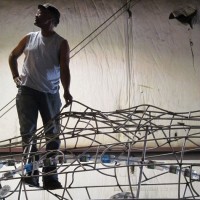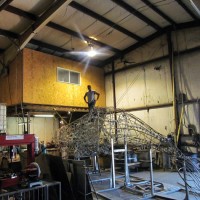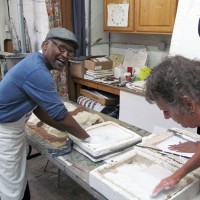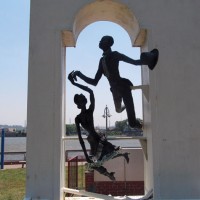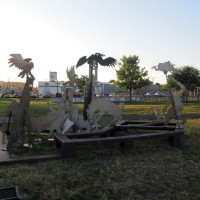News
His Art Speaks for Him
Preston Jackson expresses his beliefs in his work
It seems almost silly to ask Preston Jackson about his politics, especially if you have spent any time at all studying his work.
Yet, he isn't wild about talking about his politics, his beliefs, his innermost feelings. That's why he has art; his works that are so prevalent along Peoria's riverfront do most of his talking for him.
Those works speak out against oppression and embrace the courage to fight it. They depict the fear of subjection and celebrate freedom. They show a love of all creatures big and small and deplore the careless and senseless acts that harm or destroy them.
His art clearly protests inequality and cries out for fairness.
"My art has always been protest or social commentary. It has never been 'feel good' art," Jackson said recently while working on his next large piece of art. As yet untitled, it is a life-sized sculpture of a female sperm whale made of steel pipe. Running through the middle of the whale is a string of plastic soda and water bottles that have been discarded.
"This piece is about life. Did you know whale oil used to be harvested from the head? People would kill the sperm whale just to get the whale oil. Now a big source of destruction for these animals are the plastic bottles that have been discarded into the ocean and then get ingested by the whales," he said while standing atop the sculpture at the Bartonville warehouse where he does much of his larger works.
Hidden among the pipe structure of the whale are words the 68-year-old Jackson said sum up what is happening to the whales. Among them are "dioxin," "toxic" and "PVC."
Jackson is arguably Peoria's best-known artist. That is largely because of the finely detailed metal sculptures he has done and given to the city that are displayed along the riverfront from Constitution Gardens to Liberty Park, or work that can be seen in many local buildings. That includes the Contemporary Art Center, which he helped found and where his main studio is located But it's also because of his art that is displayed in other cities, including Chicago; much of it was commissioned.
Aside from doing his own works Jackson teaches at the Art Institute of Chicago.
Jackson is a native of Decatur, one of 10 children. He said he became an artist and story teller at a young age. That explains why, as his biography states, "His work tends to be narrative in nature, with emphasis on relating the details and personalities of our past."
To say Jackson is outspoken is an understatement but he possesses a wit that can throw off those with whom he is speaking if they aren't ready for it. His infectious laugh and sly grin gives it away that he is joking. But there is no mistaking when he is serious about his beliefs.
He said he is very much a Democrat and has always been liberal. "I think artists should be liberal, at least to the point of being flexible. Liberals are more flexible. But many artists have a difficult time expressing themselves and then what they are trying to say doesn't get interpreted correctly in their art," he said.
Jackson believes he expressed himself clearly in his work but he certainly does not expect everybody to agree with him even if they like the piece itself.
"Some people I know quietly reject my ideas. But at least they are causing some kind of reaction. I'm not afraid to express myself in my art. I don't hide behind some abstract concept that even the artist sometimes doesn't understand by the time it's finished.
"I speak out because of who I am. My whole life has been affected by racism and the many doors that have been closed in my face because of it," said Jackson. An African-American, he struggled to get studios to allow him to present his art when he was starting out after earning a bachelor of fine arts degree from Southern Illinois University. He also has a master's degree in fine arts from the University of Illinois.
Some of his works will include a plaque bearing a narrative of his thoughts at the time a piece was done. That, he said, is not so much because he believes the piece won't be understood as much as it is that he wants no question of his purpose.
"What's important to me is that people realize the truth. If they are unable to look deeper into the work that worries me. If they can't see my message they probably shouldn't look at my work," he said.
Jackson said when he teaches art he worries less about his students' technique than their style and ability to express themselves. "I teach my students how to express their feelings through their art. Consequently as I teach I am also learning. As long as I can keep that balance I will keep doing it," he said.
Sharing, he added, is a key to living. "Success to me is having happiness for a period of time. There are periods of happiness in life and that is when I feel I am living successfully. But there are also times of unhappiness. Everything changes places over time. That's why I believe life is about sharing.
"My art has allowed me to share and survive."
Indeed he has been commissioned to do many works through the years, often to do pieces about historical subjects, including a memorial for the 1908 Race Riot in Springfield, a sculpture honoring Abraham Lincoln and African American soldiers for Decatur, a sculpture of Irv Kupcinet at Wacker and Wabash in Chicago; and the stainless steel and bronze high relief about the Underground Railroad installed outside the Peoria Civic Center.
His favorites, however, are his personal works. They represent his ideas, his innermost feelings. His ideas for his art, Jackson said, "come from my fascination with life.
I'm interested in the whole idea of life. I am a devoted evolutionist, even though spirituality is really the least of my concerns."
"Right now my favorite is this whale," he said as he prepared to add more pipe to the sculpture to fill in some holes.
The whale can be transported in three sections and when completed Jackson wants to take it to different places for display, including downtown Peoria. He has been working on the whale for a year and a half and expects it will be finished by late summer.
"I love this whale. You know, a lot of artists won't touch the kinds of subjects I do, which is fine. But I don't have to do safe and comfortable," he said. "That wouldn't be me."

